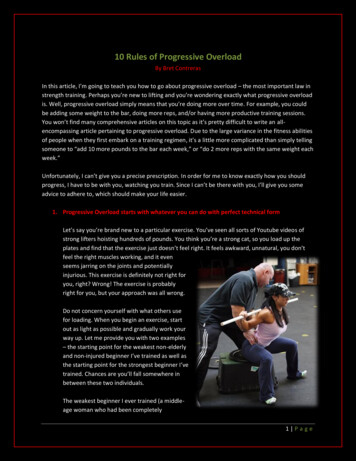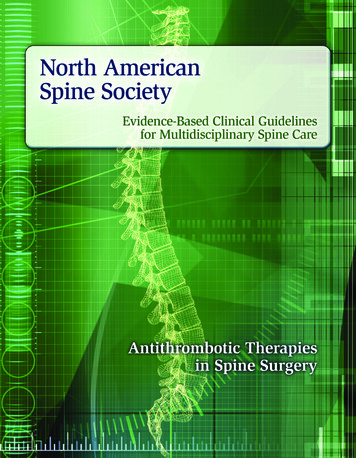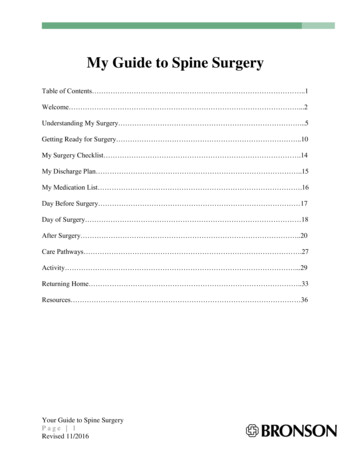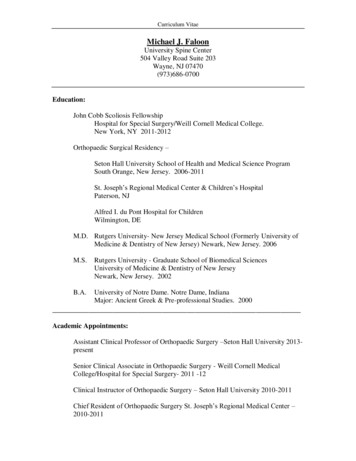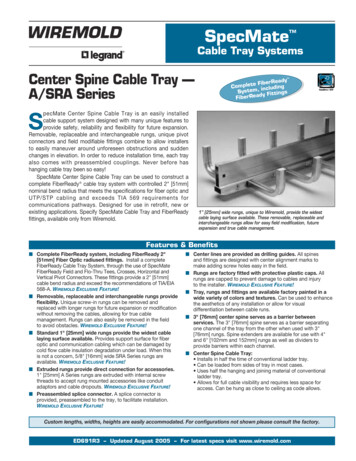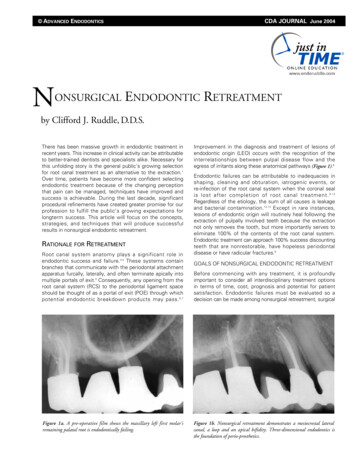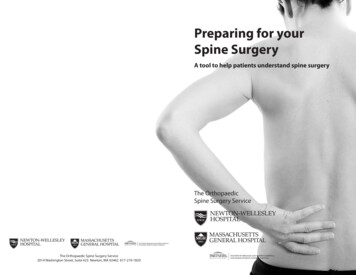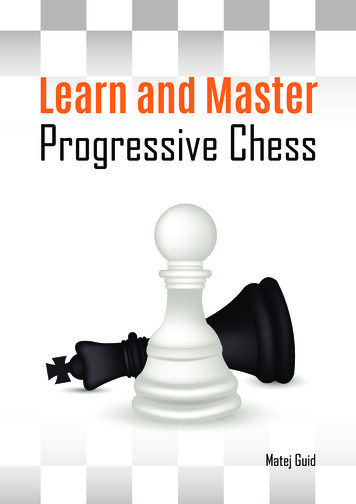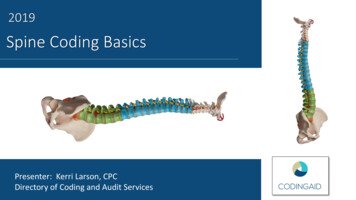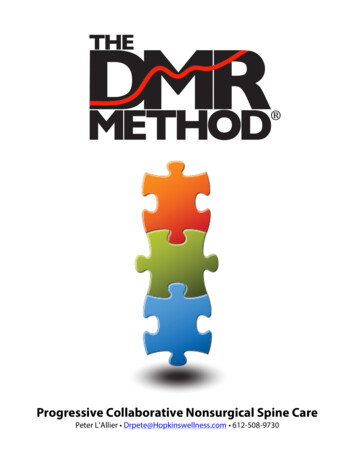
Transcription
Progressive Collaborative Nonsurgical Spine CarePeter L’Allier Drpete@Hopkinswellness.com 612-508-9730
The DMR Method The DMRMethod is a specific course of evaluation and treatment based on years of clinicalresearch utilizing pre- and post-treatment MRI scans and functional indexcase studyscores. Evaluationand treatment is provided by a team of healthcare providers that mayinclude physical therapists, chiropractors, and allied medical providers. Once the primarycause of a condition has been identified, treatment progresses through three phases:relief, repair,and rehabilitation. The primary goal of treatment is to decrease symptomsrapidly andcorrect the underlying cause of the condition by restoring mobility, alignment,and stabilityto the spine. After completing the DMR Method treatment program, the!patient is given an after-care program to independently support and sustain theirrecovery. Identify the root cause and contributing factors of apatient’s condition through a comprehensiveconsultation, medical history, and in-depth examination. Identify any conditions that require referral to othermedical providers for evaluation and treatment. Develop a treatment progression that incorporates thethree phases of recovery (relief, repair, rehab) and threegoals of treatment (mobility, alignment, stability). Manage care by closely monitoring the patient andfacilitating collaboration between the patient, treatmentteam, and allied medical providers.Progressive Collaborative Nonsurgical Spine CaretheDMRmethodDiagnoseManageRehabilitate Provide exceptional patient education and clinical care. Transition patient to a simple, specific, and sustainableindependent self-care program that supports long-termstability.
DMR arch&DevelopmentConclusions FinalDMRProtocols 3T's&3C'sDMRU
DMR Method Treatment Protocols Relief!!Goal:!Mobility! !Phase!142!IPM,!DMT!! !Phase!142!Traction! !Basic!Stretching! ent!Rehab!Goal:!Stability! Phase!243!IPM,!DMT!! Phase!243!Traction! !Advanced!Stretching! !Basic!Core!Exercises! !Phase!3!IPM,!DMT! !Phase!3!Traction! !Advanced!Exercises! rces!Basic Treatment Protocol Guidelines OUTCOMES Basic Treatment Progression n!the!optimal!path!of!recovery!!Limited Time: 4@6 Weeks Visits: 4@12 Frequency: 2@3x/wk x 1@2 wks, 1@2x/wk x 1@2 wks, 1x/wk x 1@2 wks ,)minor)sports)injuries Progressed Duration: 4@8 Weeks Visits: 12@20 Frequency: 3x/wk x 2@3 wks, 2x/wk x 2@4 wks, 1x/wk x 2@3 wks a,)cervicobrachial)syndrome Advanced Time: 10@12 Weeks Visits: 20@24 Frequency: 3x/wk x 4 wks, 2x/wk x 3@4 wks, 1x/wk x 2@4 wks hesis,)stenosis,)post/operative)conditions
.”- ‐BruceS.Healthcare Providers“Dr. Pete L’Allier first introduced me to the DMR method 8 years ago. I was impressed with thisprogressive unique spine treatment program which utilized the combined talents of chiropractorsand physical therapists. Since then, we have collaborated on many clinical case studies using MRIto evaluate pre and post DMR treatment results. I continue to be enthusiastically impressed withthe successful clinical outcomes experienced by patients participating in his programs.Congratulations on your hard work, perseverance and teamwork in creating the DMR method.”- William J. Mullin, MD Spine Radiologist“As an internal medicine physician with substantial back pain from a herniated lumbar disc, I canattest to the effectiveness of the DMR approach. I believe strongly in nonsurgical approaches toback pain so naturally tried standard physical therapy alone without success for over half a year.The pain originating in my back and shooting down my leg had become unrelenting so a colleaguesuggested I try the DMR program. After completing this program I have required only minimal,peri- odic adjustment to remain pain free and have regained my active lifestyle. I would encourageanyone experiencing back pain to complete the DMR program.”- Andrew Maresh, DO
TestimonialsPatientI am an avid runner and speed walker. After having finished my ninth week of physical therapyat another clinic and not seeing ANY improvement, I was told I should see a spine surgeon todiscuss medication and possible surgery. My husband and I decided that we would keep tryingnatural ways of treating my herniated disc until there were no options left but surgery.My father-in-law mentioned an advertisement he saw for a special treatment for herniated discscalled the DMR Method. I was extremely skeptical that the ten-week DMR Method treatmentwould be able to relieve my sciatic nerve pain from a herniated disc. However, we decided to giveit a shot.It was about three weeks into my treatment when my husband told me my leg must be feelingbetter because he hadn’t heard me complain about pain for a while. My physical therapist askedme each morning how I was feeling and each time I’d tell her that everything felt great, but I stilldidn’t know how speed walking or running would affect me.Towards the end of the ten weeks, my physical therapist said that the only way we’d know if Iwas healed was to try walking and then running. I went to the gym that night and started withfive minutes of speed walking on the treadmill and felt no pain whatsoever! From there weincreased the time and speed until I was running for thirty minutes without pain.I am extremely impressed with the attention and care I was given and would recommend toanyone suffering from back pain to give the DMR Method a chance. Now I laugh when I thinkthat I even considered surgery because this treatment got rid of my pain in less than ten weekswithout surgery or scars.-Amy F.Neurosurgeon“I’m a neurosurgeon who specializes in complicated brain and spine surgery. Although I am asurgeon my first course of action with every patient is to consider all non- surgical treatmentswhen appropriate. For many spinal conditions I’ve found that the DMR Method producesconsistent results and has an amazing ability to help patients avoid surgery. Even when a patienthas previously had spinal surgery, the DMR Method can be valuable in helping that personstabilize their spine and prevent a recurrence of symptoms and additional surgery. I alsoappreciate how they’ve built specific procedures into the DMR Method to help identify when asurgery consult might be helpful. Their team approach, with chiropractors and physicaltherapists working with other medical specialists to get a person well, is commendable. WhenI’ve worked with patients they’ve referred to me, I’m always impressed with how educated andmotivated they are. This book will strengthen a patient’s knowledge and help them understandtheir condition, the best treatment options, what they can do on their own, how to avoid surgery,and when it’s time to consider surgery. It’s a testament to the effectiveness of the DMR Methodthat most patients I refer for treatment do not need to return for surgery.”- John C. Mullan, MD
“Dr. Pete L’Allier first introduced me to the DMR method 8 years ago. I was impressed with this progressive unique spine treatment program which utilized the combined talents of chiropractors and physical therapists. Since then, we have collaborated on many clinical case studies

